Abstract
Traffic congestion poses a significant challenge to modern urban environments, impacting both driver satisfaction and road safety. This paper investigates the effectiveness of a smart traffic light system (STL), a solution developed under the Intelligent Transportation System (ITS) initiative by the Ministry of Works Malaysia, to address these issues in Malaysia. The system integrates a network of sensors, AI-enabled cameras, and Automatic Number Plate Recognition (ANPR) technology to gather real-time data on traffic volume and vehicle classification at congested intersections. This data is utilized to dynamically adjust traffic light timings, prioritizing traffic flow on heavily congested roads while maintaining safety standards. To evaluate the system’s performance, a comprehensive study was conducted at a selected intersection. Traffic patterns were automatically analyzed using camera systems, and the performance of the STL was compared to that of traditional traffic signal systems. The average travel time from the start to the end intersection was measured and compared. Preliminary findings indicate that the STL significantly reduces travel times and improves overall traffic flow at the intersection, with average travel time reductions ranging from 7.1% to 28.6%, depending on site-specific factors. While further research is necessary to quantify the full extent of the system’s impact, these initial results demonstrate the promising potential of STL technology to enhance urban mobility and more efficient and safer roadways by moving beyond traditional traffic signal functionalities.
1. Introduction
Traffic congestion is a persistent urban challenge, causing extended travel times, increased fuel consumption and air pollution, and higher accident risks. These issues have significant economic, environmental, and social consequences, demanding innovative solutions. Globally, congestion’s financial burden reaches billions of dollars annually, stemming from lost productivity and wasted fuel. Malaysia alone estimated RM13.09 billion in congestion-related costs in 2015, including lost income and environmental damage. Rapidly urbanizing cities like Kuala Lumpur face particularly acute congestion due to increased vehicle ownership. Intelligent Transportation Systems (ITS) offer a promising approach by using technology to optimize traffic flow, improve safety, and enhance air quality. This paper, however, focuses on a key ITS component: Smart Traffic Lights (STLs). We explore STL capabilities that extend beyond traditional “red and green” signal systems. This research investigates an STL implemented under Malaysia’s National Intelligent Transportation Management Center (NITMC) initiative, a Ministry of Works project aimed at alleviating congestion and improving road safety. Unlike traditional traffic lights, which rely on preset timings and often fail to adapt to dynamic traffic conditions, the STL utilizes a sophisticated approach. Integrating sensors, AI-powered cameras, and Automatic Number Plate Recognition (ANPR) technology, the STL gathers and analyzes real-time traffic data. This enables dynamic optimization of signal timings, prioritizing flow based on immediate needs. This paper contributes to the understanding of ITS in traffic management by analyzing the STL’s implementation and its impact on travel times and overall flow. This case study highlights the benefits and potential of STLs, demonstrating their viability for wider deployment. Ultimately, this research shows how STLs are transforming urban mobility, moving beyond simple red and green light sequencing towards a more dynamic, intelligent, and responsive system.
2. Literature Review
Traffic signal control has evolved significantly since early systems like the Sydney Coordinated Adaptive Traffic (SCAT) system [1]. SCAT’s pioneering vision anticipated the potential for systems to learn from traffic, adapt dynamically, and identify vehicles—concepts that became foundational to modern Intelligent Transportation Systems (ITS). This emphasis on real-time adaptation remains central to ITS research. Subsequent work has explored Adaptive Traffic Control Systems (ATCS), connected vehicle technologies, and real-time data analysis to optimize traffic signals, reduce delays, and enhance network performance [2,3]. These advancements build upon the foundation laid by early innovators. However, complex traffic scenarios, especially those involving emergency vehicles, present ongoing challenges. Prioritizing emergency vehicle movement while minimizing disruption requires solutions beyond traditional signal timing. Qin and Khan [4], offer valuable insights, proposing control strategies using real-time data and optimization algorithms to improve emergency vehicle signal pre-emption (EVSP) effectiveness. This exemplifies smart traffic management’s ability to address specific, real-world problems, moving beyond the limitations of older systems. In Malaysia, government policies actively support ITS development and implementation. The “Malaysian ITS Blueprint 2019–2023” and the “National Transport Policy 2019–2030” highlight ITS’s strategic importance in modernizing the nation’s transportation sector [5,6]. Kuala Lumpur City Hall (DBKL) explores technological solutions, including ITS, to address urban congestion [7]. The Malaysian Institute of Road Safety Research (MIROS) has developed guidelines for Tidal Flow Systems, demonstrating a commitment to innovative traffic management [8]. Furthermore, the establishment of the Malaysia National AI Office (NAIO) and the National Artificial Intelligence Roadmap 2021–2025 (AI-RMAP) signals a strong commitment to fostering a robust AI ecosystem. This focus on AI directly aligns with the technological underpinnings of ITS, particularly the AI-driven capabilities of STL. The NAIO will play a key role in promoting AI-powered solutions like STLs within Malaysia’s infrastructure [9,10]. This study contributes to this progress by evaluating STL effectiveness in addressing traffic congestion, specifically its capabilities beyond traditional systems. By examining the STL’s real-time adaptability and impact on traffic flow, this research demonstrates how these advanced systems are moving beyond basic traffic regulation towards a future of dynamic, intelligent, and responsive urban mobility in Malaysia.
3. Methodology
This study employed a mixed-methods approach, combining quantitative data analysis with visual observations to comprehensively understand the STL’s impact and its capabilities beyond the limitations of conventional traffic signal control. The STL was deployed at strategically selected intersections in State of Terengganu, Kedah and Selangor to demonstrate its effectiveness in real-world scenarios.
3.1. System Architecture and Data Collection
The STL deployed in all locations moves beyond simple red and green signalization by employing a sophisticated architecture designed for real-time traffic management. This architecture comprises the following:
- A Network of Sensors: Strategically positioned sensors were used to capture granular data on traffic volume and vehicle speed.
- AI-Powered Cameras: These cameras were deployed to monitor and analyze traffic patterns, providing a comprehensive understanding of traffic dynamics beyond basic vehicle counts. This included identifying vehicle types and recognizing unusual traffic patterns.
- Automatic Number Plate Recognition (ANPR) Technology: Integrated ANPR technology enables vehicle identification and tracking, contributing to a more detailed understanding of traffic flow and individual vehicle movements.
This seamless integration of sensors, AI, and ANPR facilitated the collection and processing of extensive real-time data, forming the foundation for the system’s adaptive capabilities. Figure 1 below is the smart traffic light’s system architecture.
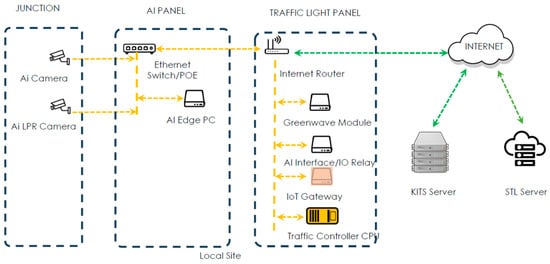
Figure 1.
Smart traffic light’s system architecture.
3.2. Study Location
The STL was implemented at strategically selected intersections across three states in Malaysia: Terengganu, Kedah, and Selangor. These locations were chosen to evaluate the system’s performance under diverse traffic conditions and urban contexts. The locations are as follows:
- Terengganu: The STL was deployed along a 6.8 km corridor on Jalan Sultan Mahmud, extending towards Jalan Kuantan–Kuala Terengganu in Kuala Terengganu. This corridor encompasses five interconnected intersections (J1 to J5). The site was purposively selected due to its high traffic volumes, particularly during peak hours, and its strategic importance in connecting key areas of the city. The interconnected nature of the intersections provided a valuable opportunity to assess the system’s ability to coordinate traffic flow across multiple junctions.
- Kedah: The STL was implemented along a 7.3 km corridor on Jalan Lencong Timur, encompassing five intersections (J1 to J5). This corridor was chosen due to its consistently high traffic density and significant congestion, particularly during commuting hours. It serves as a vital artery for both local and regional traffic, making it an ideal location to evaluate the system’s capacity to manage and optimize high-volume traffic flow.
- Selangor: The STL was installed along a 3.7 km corridor on Jalan Subang, extending towards Persiaran Jubli Perak. This included eight intersections (PE26 to PE44). This corridor was selected for its significant traffic congestion, particularly during peak commuting hours, and its importance as a major arterial road connecting to key highways within the Selangor city center. The recurring congestion provided a suitable setting to evaluate the system’s ability to manage and optimize traffic flow on a major urban thoroughfare. Figure 2 and Figure 3 below are the study location of STL.
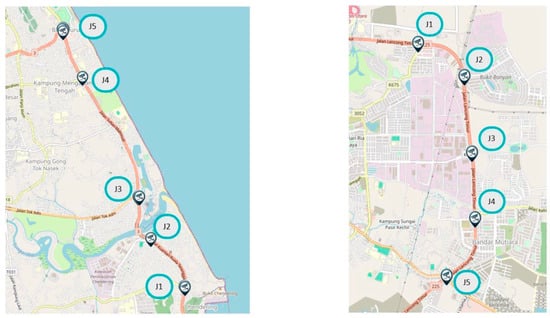 Figure 2. Location of intersection that implemented STL in Terengganu (left) and Kedah (right).
Figure 2. Location of intersection that implemented STL in Terengganu (left) and Kedah (right).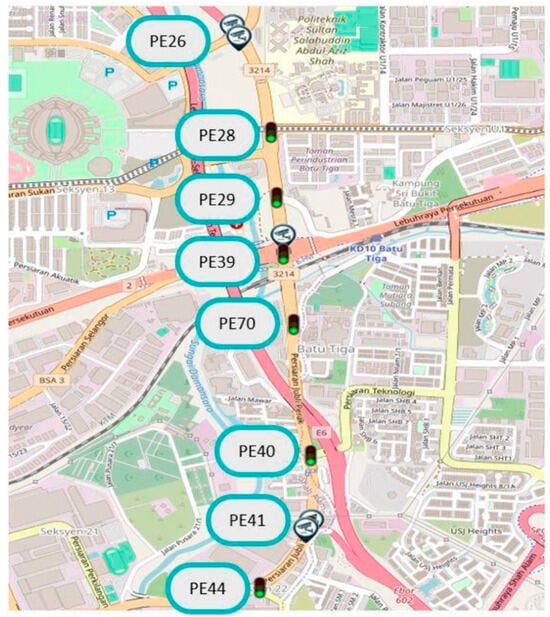 Figure 3. Location of intersection that implemented STL in Selangor.
Figure 3. Location of intersection that implemented STL in Selangor.
3.3. Data Analysis and System Optimization
The data collected was used to dynamically adjust traffic light timings, prioritizing traffic flow based on real-time conditions. The AI algorithms at the heart of the STL were trained using historical traffic data from each location. These algorithms were further refined through continuous machine learning, enhancing their predictive accuracy and responsiveness to changing traffic patterns. This iterative learning process allows the system to move beyond pre-programmed timing sequences, adapting intelligently to optimize traffic flow in a way that traditional traffic lights cannot. This methodology was designed to specifically evaluate the advanced capabilities of the STL, demonstrating how its intelligent features enable it to surpass the limitations of traditional traffic lights towards dynamic and responsive traffic management. The results of this implementation and analysis will be presented in the following section.
4. Result and Findings
This section presents the results of the STL’s implementation, demonstrating its capabilities beyond the limitations of traditional traffic signal control. The analysis focuses on the key performance indicator of travel time, showcasing the system’s ability to dynamically optimize traffic flow.
Travel Time Analysis
The analysis of travel time data collected from Terengganu, Kedah, and Selangor sites revealed compelling evidence supporting the positive impact of the STL on traffic flow. Preliminary findings showcased a statistically significant reduction in traveling times across all locations and various data collection times, as illustrated in Table 1, Figure 4, Figure 5, Figure 6, Figure 7, Figure 8 and Figure 9.

Table 1.
Result of STL implementation in Terengganu, Kedah and Selangor.
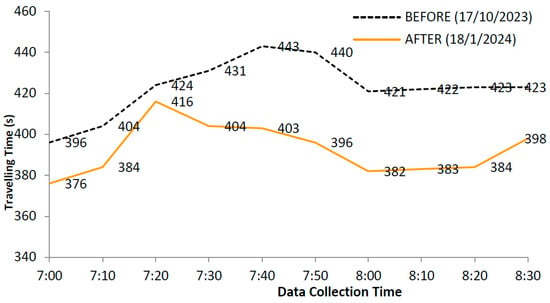
Figure 4.
The traveling time in Terengganu STL location (7.00 am–8.30 am).
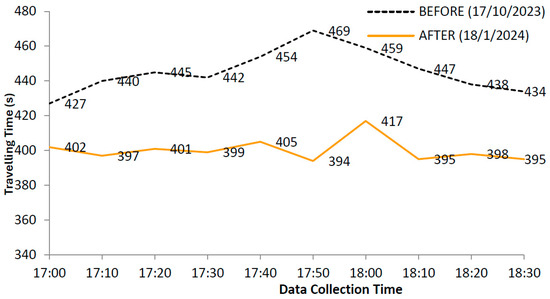
Figure 5.
The traveling time in Terengganu STL location (5.00 pm–6.30 pm).
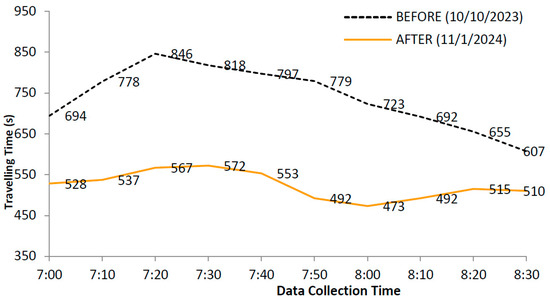
Figure 6.
The traveling time in Kedah STL location (7.00 am–8.30 am).
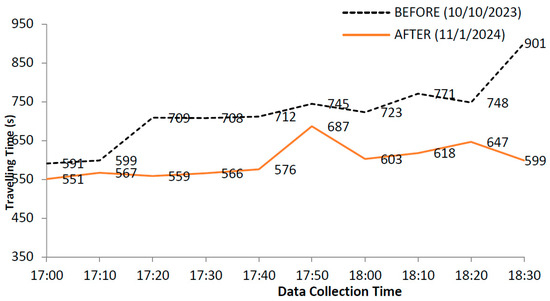
Figure 7.
The traveling time in Kedah STL location (5.00 pm–6.30 pm).
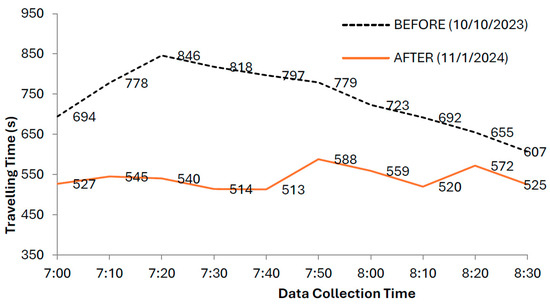
Figure 8.
The traveling time in Selangor STL location (7.00 am–8.30 am).
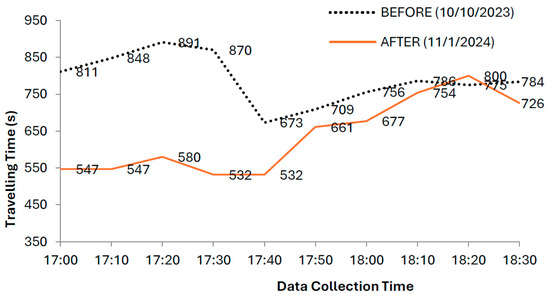
Figure 9.
The traveling time in Selangor STL location (5.00 pm–6.30 pm).
These results underscore the efficacy of the STL in adapting to real-time traffic conditions and optimizing signal timings to reduce delays and enhance traffic flow efficiency. Moving beyond the fixed-time cycles of conventional traffic lights, the STL dynamically adjusts signal phases based on actual traffic demand, as evidenced by the observed reductions in travel time. The variations in improvement percentages between locations and times of day further highlight the system’s ability to respond to the unique traffic patterns and demands of different areas and periods. The substantial reductions in travel times observed in all states—Terengganu, Kedah and Selangor—translate to significant time savings for commuters, leading to improved productivity, reduced fuel consumption, and lower emissions. These benefits have positive implications not only for individuals but also for businesses and the overall economy. Moreover, the improved traffic flow efficiency facilitated by the STL can contribute to a decrease in traffic congestion, further enhancing the quality of life in urban areas. This demonstrates the potential of intelligent traffic management systems to create more sustainable and livable cities, a clear advancement beyond the capabilities of traditional traffic signal technology. While this paper focuses primarily on travel time analysis, future research will delve into other performance indicators, such as queue length and stop time. This subsequent phase of the study will provide a more comprehensive understanding of the STL’s overall impact on traffic network performance and further highlight its advanced capabilities beyond the red and green.
5. Conclusions
This study has demonstrated the effectiveness of STL in mitigating urban traffic congestion, showcasing their capabilities that extend far beyond the limitations of traditional red and green signal systems. By integrating AI, ANPR, and real-time data analysis, STL dynamically optimizes traffic light timings, leading to significant improvements in travel times and traffic flow. The system’s adaptability to varying traffic conditions, as evidenced by the results from implementations in the states of Terengganu, Kedah and Selangor, is central to these achievements. This research underscores that the true potential of STL technology lies in its ability to learn and respond to real-time traffic dynamics, a clear departure from the static nature of conventional traffic signals. Beyond enhancing traffic efficiency, STL shows promise in improving road safety and environmental sustainability by reducing fuel consumption and emissions and further research is needed to explore long-term implications, scalability, and cost-effectiveness. The implementation of STL technology aligns with the Malaysian government’s focus on AI and ITS to address urban challenges, particularly within the framework of the National Intelligent Transportation Management Center (NITMC) initiative. As Malaysia advances towards becoming a high-tech nation, adopting innovative solutions like STL will be crucial in creating sustainable, efficient, and resilient transportation networks. This study highlights the transformative potential of STL technology, illustrating how it is not merely controlling traffic but actively shaping a new era of urban mobility. By moving beyond the simple red and green, smart traffic lights are paving the way for a brighter, more connected future, where intelligent systems optimize traffic flow, enhance safety, and contribute to a better quality of life.
Author Contributions
Conceptualization, M.F.M., M.N.M., L.C.S., A.I.H.H. and A.M.H.; methodology, M.F.M., M.N.M., L.C.S. and A.I.H.H.; software, M.F.M., M.N.M., L.C.S. and A.I.H.H.; validation, M.F.M., M.N.M., L.C.S., A.I.H.H. and A.M.H.; formal analysis, M.F.M., M.N.M., L.C.S. and A.I.H.H.; investigation, M.F.M., M.N.M., L.C.S. and A.I.H.H.; resources, M.F.M., M.N.M., L.C.S. and A.I.H.H.; data curation, M.F.M., M.N.M., L.C.S., A.I.H.H. and A.M.H.; writing—original draft preparation, M.F.M., M.N.M. and A.I.H.H.; writing—review and editing, M.F.M., M.N.M., L.C.S., A.I.H.H. and A.M.H.; visualization, M.F.M., M.N.M., L.C.S., A.I.H.H. and A.M.H.; supervision, M.F.M. and M.N.M.; project administration, M.F.M., M.N.M., L.C.S. and A.I.H.H.; funding acquisition, M.F.M., M.N.M., L.C.S. and A.I.H.H. All authors have read and agreed to the published version of the manuscript.
Funding
This Smart Traffic Light project is funded by Government of Malaysia under The 12th Malaysia Plan (2021–2025) national budget.
Institutional Review Board Statement
Not applicable.
Informed Consent Statement
Not applicable.
Data Availability Statement
All the data are described in the paper.
Acknowledgments
The authors express their sincere gratitude to the following individuals and organizations for their invaluable support of this research: The members of the project team from the Highway Planning Division of the Ministry of Works Malaysia, the Malaysia Public Works Department (Electrical Branch HQ), and the Terengganu, Kedah, and Selangor Public Works Departments (Electrical Branch); their collaboration was instrumental in the successful completion of this project.
Conflicts of Interest
The authors declare no conflict of interest.
References
- Sims, A.G.; Dobinson, K.W. The Sydney Coordinated Adaptive Traffic (SCAT) System Philosophy and Benefits. IEEE Trans. Veh. Technol. 1980, 29, 130–137. [Google Scholar] [CrossRef]
- Guler, S.I.; Menendez, M.; Meier, L. Using connected vehicle technology to improve the efficiency of intersections. Transp. Res. Part C Emerg. Technol. 2014, 46, 121–131. [Google Scholar] [CrossRef]
- Lee, W.H.; Chiu, C.Y. Design and Implementation of a Smart Traffic Signal Control System for Smart City Applications. Sensors 2020, 20, 508. [Google Scholar] [CrossRef] [PubMed]
- Qin, X.; Khan, A.M. Control strategies of traffic signal timing transition for emergency vehicle pre-emption. Transp. Res. Part C Emerg. Technol. 2012, 25, 1–17. [Google Scholar] [CrossRef]
- Ministry of Works Malaysia. Malaysian ITS Blueprint 2019–2023; Ministry of Works Malaysia: Kuala Lumpur, Malaysia, 2019.
- Ministry of Transport Malaysia. National Transport Policy 2019–2030; Ministry of Transport Malaysia: Putrajaya, Malaysia, 2019.
- Dewan Bandaraya Kuala Lumpur. Kuala Lumpur Smart City Master Plan 2021–2025. Available online: https://www.dbkl.gov.my/penerbitan-dan-laporan/kuala-lumpur-smart-city-blue-print-2021-2025 (accessed on 16 July 2025).
- MIROS. The Guideline on Implementing Tidal Flow Lane System, 1st ed.; Malaysian Institute of Road Safety Research: Kajang, Malaysia, 2023.
- Various Initiatives Prove Government’s Seriousness in Driving Ai Development-Analyst (Bernama). Available online: https://www.bernama.com/en/news.php?id=2296694 (accessed on 11 May 2024).
- Malaysia National AI Office. About NAIO. Available online: https://ai.gov.my/about-naio (accessed on 1 May 2024).
Disclaimer/Publisher’s Note: The statements, opinions and data contained in all publications are solely those of the individual author(s) and contributor(s) and not of MDPI and/or the editor(s). MDPI and/or the editor(s) disclaim responsibility for any injury to people or property resulting from any ideas, methods, instructions or products referred to in the content. |
© 2025 by the authors. Licensee MDPI, Basel, Switzerland. This article is an open access article distributed under the terms and conditions of the Creative Commons Attribution (CC BY) license (https://creativecommons.org/licenses/by/4.0/).